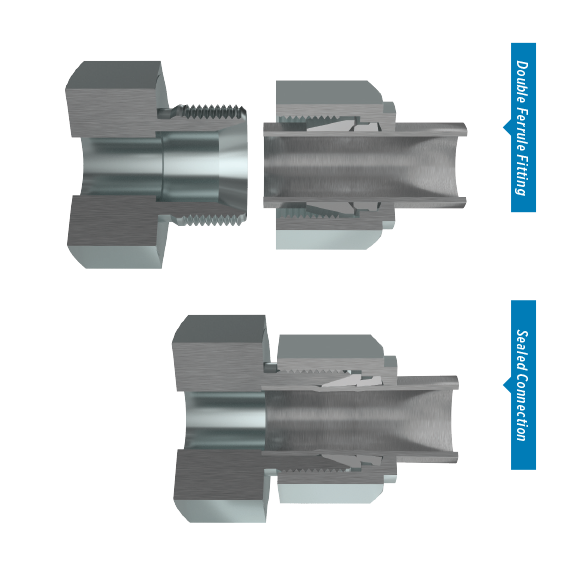- HomeHome
- Newsletter January 2023Newsletter January 2023
- BrennanBrennan
Hydraulic Fitting 101
Introduction
Hydraulic fittings contain and direct the flow of hydraulic fluid in the conductor. They also prevent leaks and maintain pressure throughout the system.
It’s important to learn the basics of hydraulic fittings to make the best selection for your system. As hydraulic fittings evolve to meet the latest safety and performance standards, it remains vital to ensure strict requirements and industry standards are adhered to during your application.
Connection Types
British Connections
British Standard Pipe (BSP) and BSPT (tapered) connections are common fitting types in the UK. Sealing takes place via distortion of the threads. Thread sealants are recommended when securing connections; they are most comparable to NPT fittings.
BSPP (parallel) is a parallel thread fitting that uses a bonded ring seal. A captive seal can be made using metal-to-metal angled surfaces or with a combination of metal-to-metal and an O-ring. The male connection is similar to, but not interchangeable with, the American male NPSM. The female swivel BSPP has a tapered nose flareless swivel, where the seal occurs on the cone seat of the male connector.
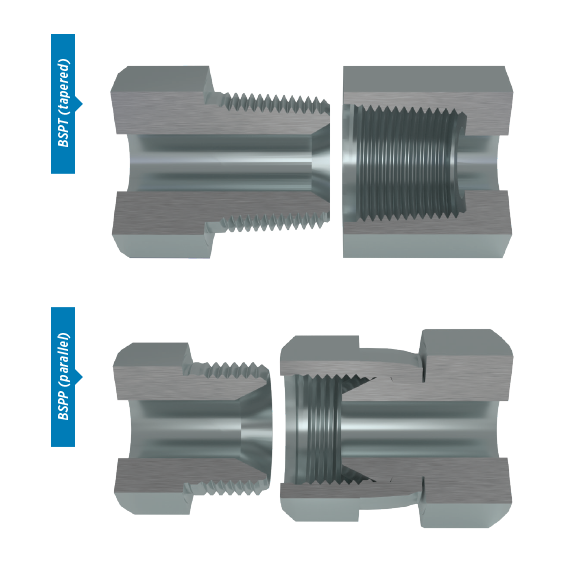
German Connections
DIN 7631 series is a metric style connection found in hydraulic systems. The male connector has a straight metric thread with a 60° angle on the recessed cone, where the female has a straight thread with a seat and tapered nose. The seal takes place on the contact cone of the male and the tapered nose of the female flareless swivel
DIN 3902 series is a male with three possible female halves. The straight metric thread male has a 24° angle. The recessed counter-bore matches the tube OD it connects to. The following can be one of the female fittings
- A tube, nut and ferrule (compression style)
- A tapered nose flareless swivel
- A tapered nose flareless swivel with DKO style O-ring in the nose
DIN 3852 is a male connector and female port. Although It is made to German specifications, it can sometimes be a reference to connectors and port designs by other countries.
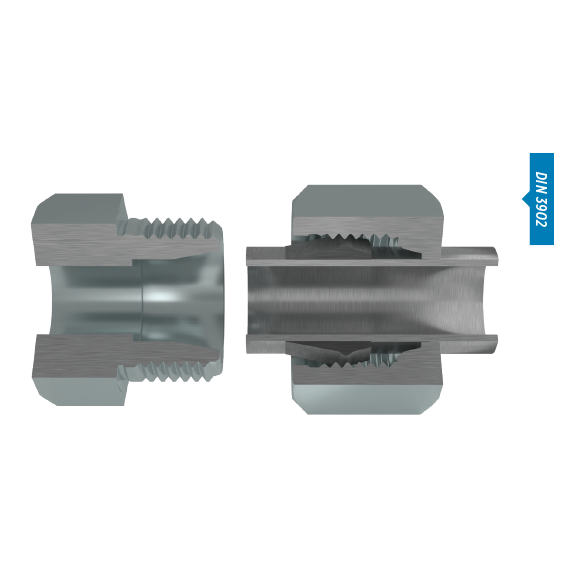
American Connections
NPT (National Pipe Tapered) pipe threads have been used for over a hundred years. NPT is a standard for tapered threads on pipes and fitting sin the United States of America. The most common use of NPT fittings is to seal pipes for fluid and gas transfer. The nominal pipe size can be identified by measuring the thread diameter and subtracting ¼”.
NPT fittings are available in iron or brass for low-pressure applications andcarbon steel and stainless steel for high-pressure.
NPTF (National Pipe Tapered Fuel) style connections are commonly used influid power systems. They have a tapered thread by which a seal is made by the deformation of the threads. NPTF threads are measured at the thread diameter and by subtracting ¼” to establish the nominal pipe size.
NPSM (National Pipe Straight Mechanical) connections are commonly used in fluid power systems. The female component incorporates a straight thread with an inverted 30° seat. The male component has a straight thread and a 30° internal chamfer. A seal is made by compression of the 30° seat on the chamfer; this is considered a mechanical connection. If an NPTF male is properly chamfered, it will also seal with an NPSM female connection.
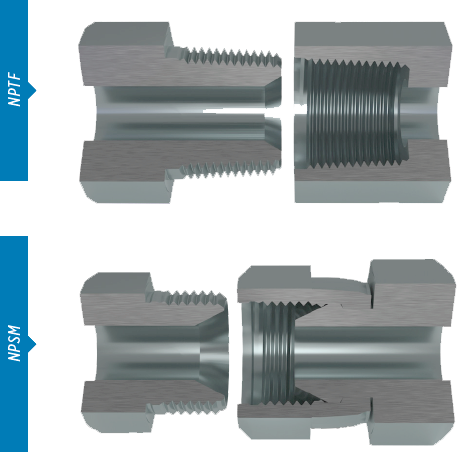
Society of Automotive Engineers Thread (SAE)
SAE J1926 straight thread O-Ring Boss (ORB) is recommended by the National Fire Protection Association (NEPA) for leak prevention in medium and high-pressure hydraulic systems. The male connection is a straight thread with an O-ring. The female port has a straight thread and a machined surface to provide a smooth, flat surface (minimum spotface), along with a chamfer where the O-ring seats. It seals when the O-ring is compressed into the chamfer when mating the male connection. This is also considered a mechanical connection.
SAE J514 JIC/37° hydraulic connections are common in most fluid power systems. Both male and female components have 37° seats. The seal is made by establishing contact between the male flared and female coned seat. This is also considered a mechanical connection.
Please note, sizes -02, -03, -04, -05, -08 and -10 of SAE 37° and SAE 45°have the same threads but NOT the same seat angles. Intermixing two different types of fittings will result in leaks. Please take care when measuring seat angles.
SAE J1453 (ORFS) O-ring Face Seal connections are considered the best for leak control. The male connector has a straight thread and an O-ring in the face. The female has a straight thread and a machined flat face. The seal occurs when the O-ring compresses onto the flat face of the female, similar to the split flange type fitting. The threads maintain the connection mechanically.
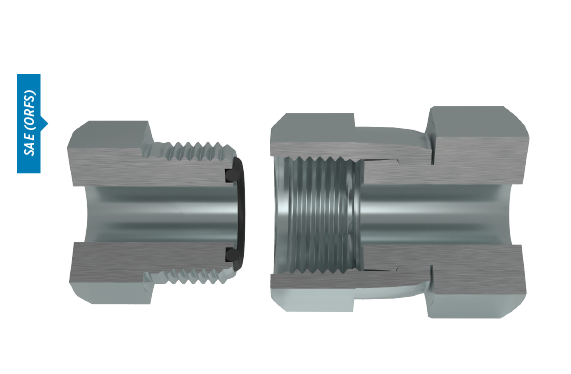
SAE J512 inverted connections are typically used in automotive systems. The male connector is usually a 45° flare within the tube fitting or a 42°seat in the machined adapter. The fittings are sealed at the flared surfaces. These threads also maintain a mechanical connection.
SAE J518 4-bolt flange*. There are two pressure ratings for these connections: Code 61 (the standard series) and Code 62 (the 6000 psi series). The design is the same for each series; however, the flange head diameters and bolt hole spacing are larger for the 6000 psi high-pressure Code 62 connection. The female port of the fitting is a smooth, unthreaded port with four bolt holes set in a rectangular pattern around the port. The male is a flanged head with a groove for an O-ring and either split or captive flange halves and bolt holes which match the port. The seal is made where the O-ring is compressed, between the flanged head and the flat surface of the port. The connection is held in place by threaded bolts.
*Excluding bolt sizes, SAE J518, JIS B 8363, ISO/DIS 6162 and DIN 20066 are interchangeable.
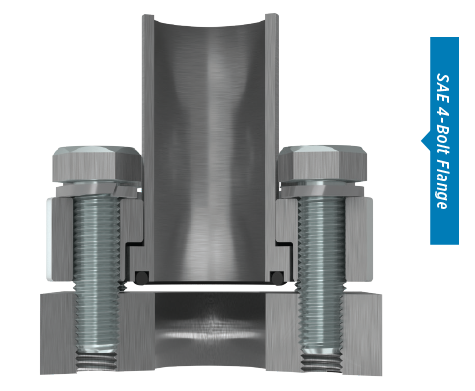
ISO Connections
ISO/DIS 6162 4-bolt flange is a common connection found in fluid power systems. There are two pressure ratings for this connection: Code 61: PN35/350 bar (standard series) and Code 62: PN 415 bar (high pressure). Both connections maintain the same design, yet the bold hole spacings and flanged head diameters are larger on the PN 415. Inch or metric bolts are found in these connections. However, there is an ‘M’ stamped on the port if metric bolts are to be used. The female port of the fitting is a smooth, un-threaded port with four bolt holes set in a rectangular pattern around the port. The male is a flanged head with a groove for an O-ring to seat and split or captive flange halves and bolt holes which match the port. The seal is made where the O-ring is compressed between the flanged head and the flat surface of the port. The connection is held by threaded bolts.
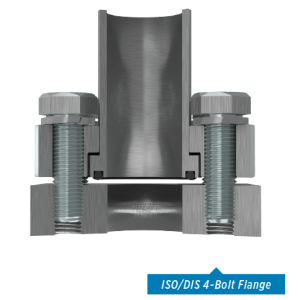
ISO 6149 port and stud ends with ISO 261 threads and O-ring seal is similar to the SAE J514 straight thread O-ring Boss (ORB). This connection incorporates metric threads. The male connector has straight threads with an O-ring. The female port is straight threads machined surface to provide a smooth, flat, accurately located surface with minimum spotface. This also applies to the O-ring seats which seals when the O-ring is compressed into the chamfer while mating with the male connection. This is considered a mechanical connection.
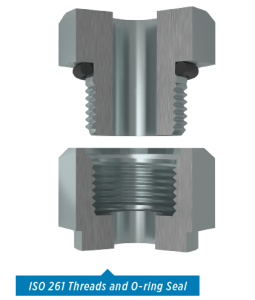
Japanese Connections
JIS Tapered Pipe (PT) has metric threads per JIS B 0203. This connection is comparable to the design of the BSPT connections in their dimensions and appearance. The connections are also interchangeable with BSPT connections.
JIS 30° male inverted seat connections are parallel pipe threads per JIS B0202. JIS parallel connections are comparable and interchangeable with BSPP connections.
JIS 30° female (cone) seat are parallel threads per JIS B 0202. Japanese JIS 30° flare connections are comparable to American SAE 37° flare connections in application and sealing. However, JIS 30° flare angle and dimensions are different with the threads being similar to BSPP.
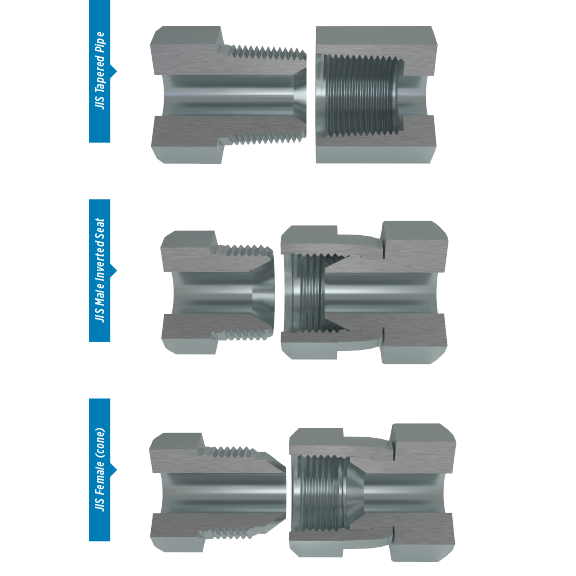
JIS B 8363 4-bolt flange connections are frequently used in fluid power systems. There are two pressure ratings for JIS B 8363 4-bolt flange fittings:
- Type I Code 61 (standard series 4-bolt flange).
- Type II Code 62 (6000 psi series).
The flanged head diameters and bolt hole spacing are larger for Type II6000 psi connections. Metric and inch bolts are each used with these connectors. The male connector has a flanged head with a groove for seating an O-ring and either a captive flange or split flange with boltholes to correspond to the port. The female port of the fitting is a smooth, un-threaded port with four bolt holes set in a rectangular pattern around the port. The seal is made when the O-ring is compressed between the flanged head and the flat surface of the port. The connection is held in place by threaded bolts.
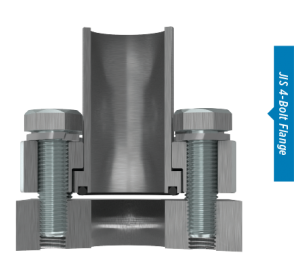
JIS 210 Kgf/cm2 4-bolt square flange incorporates a JIS 4-bolt square flange connection which is comparable to SAE 4-bolt flange connections with the only difference being the flange and the JIS bolt pattern being square.
Instrumentation Fittings
Double and single ferrule instrumentation fittings are widely used in fluid or gas transfer. The most common applications are in refineries, chemical and food processing plants. The male end of a double-ferrule instrumentation fitting has a recessed counter-bore which matches the tube OD being used, plus an inner cone. The seal is made between the front ferrule and the cone. The tubing is held in place by the swaging action caused by the tightening of the nut. This forces the front and back ferrules to bite into the tubing, firmly holding it in place. This allows for the use of an un-flared tubing with these connectors.
The single-ferrule instrumentation fitting is similar but has a larger front ferrule and no back ferrule. The sealing method is also similar. Both types of instrumentation fittings are commonly available in stainless steel and brass.
Instrumentation fittings have UNEF (extra fine) threads and sizing is determined by the outside diameter of the tubing being used.
